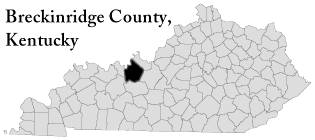 |
USGenWeb Archives Project Breckinridge County, Kentucky |
 |
 |
 |
 |
 |
USGenWeb Archives Project Breckinridge County, Kentucky |
 |
 |
 |
 |
THESE
ARCHIVES BUILT BY YOUR
CONTRIBUTIONS.
PLEASE CONTRIBUTE TODAY!
New
Easy to use Submission
Forms!
This Page Updated Monday, 11-Apr-2022 20:27:44 EDT
| BRECKINRIDGE COUNTY, KENTUCKY |
| AREA COMMUNTIES OF THE PAST AND PRESENT |
| FALLS OF ROUGH |
Perhaps one of the most colorful and picturesque places to
be
found anywhere is at the Falls of Rough River on the boundary
line
between Breckinridge and Grayson County.
One o fhte most
interesting stories in Kentucky history has been the unfolding of
events at the
Falls of Rough. Long
before any white men came west of the
Appalachian Mountains, the ancient people, or Indians, had
congregated at this
point. There was a
long and steep rapids in Rough River and
there has been found in this vicinity many Indian relics that
definitely belong to
several different tribes indicating that the falls was well known
to the red man. Due
to the power of the falls it has been a
site of a mill since
1790. The first
white settler at the Falls of Rough was a
Mr. George Wilson from North Carolina.
It was he who built
the first dam.
One of the first judges of the Kentucky Court of Appeals
was
Benjamin Sebastian. In
1803, Kentucky had been fairly well
populated, and some one thousand people inhabited Breckinridge
County. In this
year (1803) Thomas Jefferson, president of
the United
States, succeeded in purchasing from France for the sum of
$15,000,000 what is known as the Louisiana Purchase.
This
doubled the size of
the United States. Alexander
Hamilton had been challenged
by Aaron Burr to a duel in which Hamilton was killed.
Because
of this duel,
Burr became very unpopular in the East and came to Kentucky.
On arriving in the West, Burr spent a few days in
Lexington after
making the
acquaintance of Benjamin Sebastian and James Wilkinson.
He
later went to Nashville, Tennessee, where he spent some time with
Andrew Jackson.
It was on this
trip that Burr decided to take over the
Louisiana Territory and become King Burr.
Right at this
particular time, which was
just prior to our second conflict with England (War of 1812)
Kentucky was experiencing trouble with the Indians of the
Northwest and our only trade
outlet was down the Ohio and Mississippi Rivers to New Orleans.
Burr conceived the plan of trading Kentucky to the Spanish
for
their support in
securing the Louisiana Territory.
It was about 1806, that
Judge Sebastian became one of the foursome (Aaron Burr, Judge
Innes, James Wilkinson,
and Benjamin Sebastian) in what is known as the Burr Conspiracy
or Spanish Conspiracy. It
was discovered the Judge
Sebastian, while he was
a member of the Kentucky Court of Appeals, was drawing a pension
of $2,000 a year from King Charles of Spain and on December 6,
1806, the Kentucky
House of Representative voted the articles of impeachment against
Judge Sebastian. He,
together with Aaron Burr and
Wilkinson, was indicted.
Henry Clay was the
attorney for Aaron Burr and Ben Hardin,
formerly of Elizabethtown or Hines Fort as it was originally
called, was attorney for
Judge Sebastian. This
Ben Hardin is the same one, who was
the first Commonwealth Attorney of Grayson County.
Henry
Clay was undoubtedly
the greatest lawyer in the west and Burr was acquitted upon the
technicality that no overt act of conspiracy upon his part had be
established. Mr.
Ben Hardin saw that it was a foregone conclusion that the senate
would convict Judge Sebastian upon the articles of impeachment,
so he asked for a compromise,
whereby the charges would be dismissed, if Sebastian would resign
as the Judge of the Court of Appeals.
It is my opinion that
Judge Sebastian was a
loyal Kentuckian who had been misled into believing, due to
geographical conditions, Kentucky would prosper more as a Spanish
Colony. Judge
Sebastian, with this blemish upon his character, in order to get
away from the public gaze, went to what is now Falls of Rough in
both Breckinridge and Grayson
County and purchased several thousand acres of land.
Some
years later he went to Washington D. C. and met with the older
Willis Green who at that time
was a member of Congress. While
he was in Washington he
sold to Willis Green his entire holdings in Kentucky.
Colonel Willis Green came in possession of this land in
1820.
In 1823, he built the house, store, and mill that stands
there
today. George
Wilson built the first dam and Benjamin
Sebastian built the second one across the river.
It too was
made of logs and did not last too long.
It washed out after Mr. Green took it over.
Mr. Green built
the dam out of rock but made the mistake of running it straight
across the river even though it
was tied well at each end. It
lasted for several years but
a flash flood hit the same in 1855 and it split in two in the
middle and opened up like a giant double
gate that’s hinged on each end and fastened in the middle.
At this time the Green estate had fallen into the hands of
Mr.
Lafe Green. Money
was scarce at the Green plantation and he
had to make some move so he borrowed $20,000 from B. F. Beard in
Hardinsburg to rebuild the dam. Mr.
Beard had just recently
returned from California, where he had participated in the
’49 Gold Rush, and was one of the fortunate ones who struck
it rich. His
wealth, however, was not gained by pick,
shovel, and gold pan. He
was one of the smarter ones who
made his fortune in straight business deals and lived
to bring it home. After
borrowing the $20,000 Mr. Green
rebuilt the dam from stone. The
work was done by a Mr.
Edgar Bennett, one of the finer
stone masons of Basin Springs. Each stone in the base layer had a
hole drilled in it and a matching hole drilled in the solid
bedrock in the bottom of the riverbed.
An iron pin was
put in these holes making it impossible
for the base of the dam to move. This
rock dam was built on
an angle where the pressure
above only tended to strengthen it and it stands today a tribute
to the ingenuity of its builder.
There was enough lumber sawed in this old mill to more
than have
built a barn over the entire 5,000 acre tract of land.
The
old circle saw
that was installed in 1823, was replaced by a large 6 foot by 8
inch band saw in 1914. This
saw was used until 1921, then
replaced by a larger one, 6 ft.
by 10 in. Timber of
the quality that the Green Brothers, as
they were known by now, needed to saw was becoming scarce, so the
mill became silent in 1933. The
mill was torn down in 1938,
and ironically, as the Old Branch line of the L & N Railroad
wabbly supported the last train of its career in June, 1941, it
carried
with it the old Falls of Rough sawmill.
It was shipped to
Florida and sold to the Miller Brothers Lumber Company.
Mr. Lafe Green died in 1907, leaving three boys and one
girl:
Willis, Rob, Preston, and Jenny.
None of them were ever
married. The Green
Brothers were very thrifty business men.
At one time during the late teens, from 1915 to 1920, they
owned
8,000 acres of land. In
1945, when the farm census was
taken, this was a multiple unit operation so the state supervisor
was called in to assist in the census taking.
Upon
completion he said that this was the largest single farming
operation in the state of Kentucky.
The flour mill had a 25 barrel per day capacity and
operated on
an average of 250 days a year, grinding some 6,250 barrels of
flour per year. It
shut down only when the river was
flooded.
Their best grade of flour was called “Grayson
Lily”,
the second was called “White Rose”, and the third
grade
was named “Good Enough”.
Much of this flour was
shipped to Louisville for further distribution, the rest was sold
in the surrounding counties for a radius of 75 to 100 miles.
Many farmers in the near-by communities sold their wheat
to the
Green Brothers but left a certain amount in storage for their own
use. They could
then go to the mill and get a barrel of
flour when they needed it. The
mill exacted a toll of
one-twelfth for their storage and grinding fee.
Eight 24
pound sacks constituted a barrel, but each sack had only 23
pounds, coming four pounds short of a standard barrel of flour,
but the cost of the
sacks was responsible for this shortage.
The meal from the Falls of Rough mill was named
“Old
Fashioned Water Ground”.
They never used any corn
except what they produced
themselves, and it was all “Boone County White,”
because this variety has a white cob and does not leave any
little red specks in the meal.
The Old Green mansion is fabulous, and the furniture and
silver
ware, much of which was made from the old Spanish silver coins,
was something you
only read about in books. The
library, itself, was
doubtless worth a king’s ransom, but like all the rest which
history records, Father Time, like the miller
himself, began taking his toll. Willis
was first to go,
then Rob, then Preston, leaving only Jenny to hold the fort.
On September 3, 1965, the final toll
was taken. Miss
Jenny, last leaf on the Green tree, at the
age of 85 years and 11 months, passed on to her reward.
This was the end of a generation and the end of a great
family.
One dynasty has passed on and the land which rightfully
belongs
to mother
nature, into whose bosom the Green family has taken refuge, is
passed into the custody of a cousin from Texas, a Mr. and Mrs.
McGee, who have seven children.
Thus a new dynasty
at the Falls of Rough is born.
George Washington did on 5,000 acres of land in Grayson
County
near Falls of Rough; however, none of the Green farm was included
in the
Washington boundary. This
tract of land was acquired by
George Washington from Richard Henry Lee, commonly known as
“Light Horse Harry.”
This deed, at the time, was
located in Hardin County, which was formed from Nelson County in
1792. The deed sets
out in consideration 600 pounds
current money of Virginia, which was equivalent to $10,000, but
the real basis of the trade was the transfer of Washington to Lee
of his famous horse, “Magnolia.”
Lee had always
wanted to own this horse, and on December 9, 1788, George
Washington made this entry in his diary:
Concluded my exchange after dinner today with Colo. Hy.
Lee of
Magnolia for 5,000 acres of Ky. Land.
On December 11, 1788, Lee wrote to Washington as follows:
It is probable I may take Magnolia in one or two days and
send
him to South Carolina. Then
let me ask the favor of you
furnishing
me with
his pedigree and age, certified, and your bill of sale. The
lands I pay for him I estimate at 500 lbs.
Washington’s 5,000 acres of land lay in two
tracts: one
3,000 acres and the other 2,000 acres.
They lay on the
south side of Rough
River just below the mouth of Caney Creek, what is now the Yeaman
community.